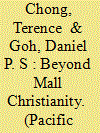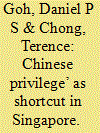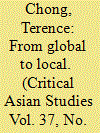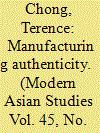| Srl | Item |
| 1 |
ID:
184237


|
|
|
|
|
| Summary/Abstract |
The global spread of Pentecostalism has been facilitated by a combination of transnational impulses and indigenizing interests. In the case of independent Pentecostal megachurches, their growth in urban centres is reflected in both Western and Asian societies. Megachurches in America and Southeast Asia have flourished because of their unique blend of middle-class congregants, appeal to consumerist and popular culture, as well as their compatibility with the urban lifestyle patterns of their congregants. However, it would be a mistake to assume that the drivers of growth and the conditions behind the common features of these megachurches are the same. Examining Jakarta, Surabaya, Kuala Lumpur, and Manila, we show that megachurches are not located in shopping malls and commercial complexes merely for growth purposes or to align with the consumerism ethos of capitalism. Deeply local concerns, such as hostile neighbourhoods dominated by Muslim or Catholic majorities, have led to the camouflaging of Christian symbols in urban settings. The purposeful targeting of youth also reveals the Southeast Asian megachurch engaging with the new urban mobilities triggered by rapid economic development. We conclude that the Southeast Asian city’s structure and layout are being repurposed by Christian innovation and reinterpretation. Christianity in the Southeast Asian city is hidden in plain sight.
|
|
|
|
|
|
|
|
|
|
|
|
|
|
|
|
| 2 |
ID:
185506


|
|
|
|
|
| Summary/Abstract |
We disagree with Humairah Zainal and Walid Jumblatt Abdullah that Chinese privilege exists in Singapore politics and that it is perpetuated by the political hegemony of the long-ruling People’s Action Party (PAP). Consequentially, we disagree that ‘Chinese privilege’ is thus a useful concept for understanding politics in Singapore. Our rejoinder argues that ‘Chinese privilege’ is under-specified and decontextualized by the authors, used uncritically as a shortcut for the consequences of the long-ruling party’s political hegemony for ethnic relations, and is therefore a polarizing distraction to the critical analysis required to advance anti-racism discourse and understanding in Singapore. We show that the authors have mistook incumbent political privilege for Chinese privilege. We argue that ethnic majority and minority Members of Parliament from both governing and opposition parties have had to simultaneously serve as community leaders and transcend ethnic affiliations to represent national interests.
|
|
|
|
|
|
|
|
|
|
|
|
|
|
|
|
| 3 |
ID:
071010


|
|
|
|
|
| Publication |
2005.
|
| Summary/Abstract |
This article explores the effects of Singapore's Global City for the Arts project on the local theater industry. It begins by describing the character of the Singapore state and its ability to meet the challenges of globalization. It then shows that while historically global in orientation, the city-state's early cultural policies were resolutely local and insular prior to the economic recession in 1985. From that year on, local arts and culture was driven by an economic rationale - eventually culminating in the birth of a globally oriented national cultural policy: the Global City for the Arts project. The author contends that the Global City for the Arts project has pressured the Singapore state into shedding some of its authoritarian practices in order to conform to international norms. However, the author also illustrates how certain theater companies with the requisite cultural capital for the Global City for the Arts project have benefited from the country's cultural policies while others that do not possess such cultural capital are marginalized. The article concludes by arguing that the Singapore state, in going global, exacerbates the economic disparity by accentuating preexisting inequalities and divisions in the local.
|
|
|
|
|
|
|
|
|
|
|
|
|
|
|
|
| 4 |
ID:
083156


|
|
|
|
|
| Publication |
Singapore, Institute of Southeast Asian Studies, 2008.
|
| Description |
xii, 416p.
|
| Standard Number |
9789812304889
|
|
|
|
|
|
|
|
|
|
|
|
Copies: C:1/I:0,R:0,Q:0
Circulation
| Accession# | Call# | Current Location | Status | Policy | Location |
| 053799 | 337.159/CHO 053799 | Main | On Shelf | General | |
|
|
|
|
| 5 |
ID:
105287


|
|
|
|
|
| Publication |
2011.
|
| Summary/Abstract |
According to Prasenjit Duara, the sacredness of the nation hinges on its 'regimes of authenticity' where timelessness and the politics of embodiment are key to an authentic national identity. This paper looks at three different cultural impulses that have attempted to manufacture authenticity in Singapore. They are: the Malay literary movement Angkatan Sasterawan 50 prior to independence; the state-sponsored Confucian ethics discourse during the 1980s; and the romanticization of the working-class 'heartlander' through contemporary popular culture in confrontation with the politics of global capitalism and globalization. In doing so, this paper articulates the difference between the regimes of authenticity of state elites and non-state cultural producers, as well as their 'national imaginaries'. It concludes that the regime of authenticity, that operationalizes the representations of the working class as a diametric opposite to the logic and force of globalization, offers the most popular symbols of national identity in Singapore.
|
|
|
|
|
|
|
|
|
|
|
|
|
|
|
|